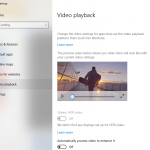After a Windows 10 computer wakes up from sleep mode or sometimes from hibernate mode, the display appears to be dimmer than usual. Upon checking, brightness level of the device is automatically reduced, sometimes more than 50% which makes the screen much darker. The issue happens even though the settings within the active power plan does not offer the option to change display brightness option, or is configured to only change display brightness only when the device changes between on AC power or battery power.
While the reason on why unexpected screen brightness dim happened is unclear, and may probably related to power savings (lower brightness saves power), here’s a few steps that you can take in order to resolve the issue.
Method 1: Manually Adjust the Brightness Level Bar
The immediate fix the screen display dim issue after waking up is by adjusting the brightness up manually. Brightness level in Windows 10 can be changed easily through Settings (in System -> Display), or through the slider at the bottom of expanded quick actions section of action center (notification pane at the right side of Taskbar).

Note that manually adjust brightness level if display is dimmed after waking up is temporary remedy, as the issue likely to persist on next wake up.
Method 2: Restart the PC
Sometimes, the Windows 10 operating system may just behave erratically if it’s not resting (shutdown) for a long time. Restarting the device may just magically solve the display is automatically dimming to lower brightness issue on waking up from sleep.
Method 3: Disable Automatic Brightness Level Change
Some PCs especially those with ambience light sensor allows Windows 10 to automatically adjust screen brightness based on the current lighting conditions. The automatic change of brightness may cause the problem. To disable, go to Settings -> System -> Display. Under Brightness and color, and uncheck the Change brightness automatically when lighting changes check box.
Method 4: Update the Display Adapter Driver
Go to Device Manager from Win+X menu (or search for and open Device Manager). In Device Manager, select Display adapters to expand the tree. Right click (or tap and hold) the display adapter name that is installed on the device, then select Update driver. In the “Update Drivers” wizard, select Search automatically for drivers so that Windows 10 can automatically get the latest supported version of driver for the GPU. Alternatively, if you have downloaded the latest graphics driver from GPU manufacturer, you can also select Browse my computer for drivers to manually select the folder which driver located.

Method 5: Reinstall the Display Adapter Driver
Go to Device Manager from Win+X menu (or search for and open Device Manager). In Device Manager, select Display adapters to expand the tree. Right click (or tap and hold) the display adapter name that is installed on the device, then select Uninstall driver. Then, restart the computer. Upon boot up, Windows 10 will automatically detect the display the adapter and install the appropriate stable driver for it.
Method 6: Update the BIOS
Make sure that you have downloaded and installed the latest version of BIOS firmware as the manufacturer may aware of the screen dimming issue and provides fix for it, especially if the PC originally shipped with non-Windows 10 OS, such as Windows 7 or Windows 8/8.1, and then you perform an upgrade to Windows 10. You can search for and download latest BIOS update from PC or motherboard manufacturer’s website.
Method 7: Run Power Troubleshooter
If you suspect the computer’s power plan or power settings may be at fault, you can try to run Power troubleshooter. Go to Settings -> Update & security -> Troubleshoot -> Additional troubleshooters, and select Power, then hit Run the troubleshooter button.
Method 8: Make Sure Monitor Driver is Working Properly
Though not as important, the device driver for monitor may cause the problem. Go to Device Manager’s Monitors tree and make sure that monitor’s driver is not disabled or is not indicated with error. If yes, then fix any error.
Method 9: Disable All Possible Smart, Intelligent and Automatic Adjustment of Screen Brightness
A lot of PC manufacturer includes utilities that that can perform automatic adjustment of system power settings that may affect display brightness in order to conserve battery or maximize performance. For example, Dell Power Manager, Lenovo Vantage, HP Power Manager and etc. Some of these utilities, especially those that attempt to adjust power settings smartly, intelligently and automatically, may interfere with optimal performance of the computer. Try to set the power settings to always maximize the performance to see if the display brightness issue is resolved.






